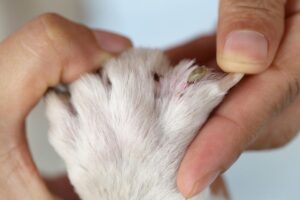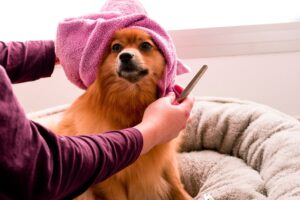Easy At Home Pet Assessment
The importance of knowing what is normal and abnormal for your pet
By: Andrea Cormier, Registered Veterinary Technician
The importance of knowing what is normal and abnormal for your pet can help detect health issues before they become severe. This article will provide a guide to completing an easy at home pet assessment.
Having a pet brings so much joy into your life. They provide a friendship unlike any other. It can be incredibly stressful when they get sick, or when you notice something “abnormal” on/about them. Doing routine at home exams can help you to know when your pet isn’t feeling well or if they acquire something new on their bodies.
These exams are quick and easy; you should be able to assess your pet in under 5 minutes! It is important to start getting your pet used to being examined as soon as you get them, whether you bring them home as a baby or adopt them further along in life.
Easy at home pet assessment | Head
Start with the head and move your way down. The things you are looking for are: hair loss, lumps or bumps or even some sneaky parasites. Ticks like to latch onto dogs around the ears, above the eyes or even on the lips. Check inside your pets ears, and make sure you know what is normal for them.
If they have lots of hair in there, speak with your groomer about regular trimming or learn how to do it at home. If their ears have a smell, are red or have discharge it is probably time to book an appointment with your veterinarian for an exam as these can all be signs of an underlying condition.
The next areas on the face that you should be paying attention to are the eyes, nose and mouth. The eyes can be especially telling when your pet is unwell. It is normal for some pets to have watery eyes or tear staining, but recognizing when that changes is very important too. If the discharge from your pets eyes is green or yellow, that is a sign of infection.
You will also want to take note of things like squinting or inflammation around the eye. Dogs and cats can get pretty significant eye infections that can leave permanent ocular damage, so anytime you are concerned about your pet’s eye health please make an appointment with your veterinarian. The nose is up next, and just like the eyes it can tell us a lot about your pet. Nasal discharge is an early sign of infection, which can in some cases be contagious to other pets you may have in your household.
The mouth can be trickier to assess on a regular basis, especially in small pets like Rabbits, Guinea pigs or Hamsters. Opening up your pet’s mouth and taking a look can save you lots of money in the long run, as well as keep your pet healthy for many years.
Dental disease can cause significant illness to a pet if left untreated. Animals can see changes in liver values on bloodwork and it can even lead to heart disease in severe cases. Checking for tartar build up, gum irritation and broken teeth is very important.
Catching dental disease before it progresses is key to your pets overall health. Small animals like rabbits and guinea pigs have teeth that never stop growing.
It is up to the pet owner to provide them with chew toys that help to keep the teeth short and healthy. Sometimes pets like these can have abnormalities in their bite, also known as a malocclusion. A malocclusion can lead to significant health issues for these types of animals. They need their teeth to eat and if they can’t do that, they will become sickly quite fast!
Once you are comfortable handling your pet regularly, these check overs will become a habit and you can make it a positive experience using treats and toys. When you are checking the overall body of the pet you are looking for things like: body condition, lumps or hair loss.
Easy at home pet assessment | Body
Checking body condition is probably the most important thing any pet owner can do. Running your hands along your pet’s rib cage, abdomen and hips can tell you a lot about their health.
When feeling over the ribs of your pet, you should be able to lightly feel the ribs, but they should not be poking out of the skin. Here is a good trick – make a fist with your hand, run your finger along your knuckles.
The knuckles are prominent and should be protruding out, if you are feeling this on your pet, then it could be a sign that they are underweight. Flatten your hand out now, do the same motion and feel your knuckles. They should feel present but not prominent; this is a healthy body condition of a pet. The belly should also have a nice dip in and the hips should not be prominent.
It is important to note that every breed is different, some will be leaner than others. As a pet owner you should be aware of the healthy weight ranges for your pet and speak to your vet regularly about any concerns you may have over your pet’s body condition.
Just as your pet can be underweight, you may instead notice weight gain. Pet obesity can lead to many illnesses in the long run, so making sure your pet is on a proper diet is key to a good body condition and overall health.
While performing any at home assessment you want to make sure your pet is not exhibiting any signs of stress or anxiety. Be aware of their comfort level, and give them a break if you notice any serious changes in their behavior. Try to keep the assessment fun by keeping treats nearby or distracting them with a toy if possible.
While feeling along your pet’s body you are also going to feel around the belly and sides for any lumps. Any lumps found in and around the mammary chain are very important to get checked out and monitor for changes. Hair loss on the body is very important to note as well. Some conditions such as Cushing’s disease can present with hair loss.
Easy at home pet assessment | Coat
Other important conditions that can present with hair loss are allergies, parasite infection or even a simple skin infection. Any hair loss or change in hair coat is very important to report to your veterinarian. Another key thing to note is change in odor, a lot of skin infections can cause an odor change for a pet. So make sure to note that when speaking with your veterinary professional.
 At this point, you have assessed your pets face; including the eye, ears and nose. You are now comfortable assessing body condition and hair coat health. We now need to move onto the feet and tail area. The feet are tricky for most animals, as they do not like them touched. So, go slow and use lots of positive reinforcement. Assess nail health; Are any of the nails broken?
At this point, you have assessed your pets face; including the eye, ears and nose. You are now comfortable assessing body condition and hair coat health. We now need to move onto the feet and tail area. The feet are tricky for most animals, as they do not like them touched. So, go slow and use lots of positive reinforcement. Assess nail health; Are any of the nails broken?
Does your pet have any inflammation or hair loss on or around the feet? A fractured nail can be quite painful for a pet and can cause a lot of bleeding when it does happen. Going to the vet to get it fixed is very important for your pets’ nail health and overall wellbeing.
Many pets with allergies tend to lick or get irritation on their feet. Noting any discoloration, inflammation or odor is very important. This should be discussed with your veterinary health care team as soon as possible. Pets, just like you and I, can be sensitive to certain things, so noting any changes in household cleaners or outdoor sprays can be very helpful.
Easy at home pet assessment | Tail
It may not seem like a pleasant experience but checking the tail area is very important for your pet’s health and can really tell you a lot! Noting abnormal behaviors like scooting or excessive licking can mean there is something irritating happening back there.
It may be an easy fix like full anal glands that you can have expressed by a veterinary professional or a groomer. But sometimes anal glands can get infected and this can cause a lot of pain for a pet. So noting any change in redness or inflammation is key.
Excessive licking or scooting can also mean other things like parasite infections or food allergies. Make sure to let your veterinarian know how long you have noticed the behavioral changes. Advise of any improvements after any medical intervention has happened. Other things to note around the tail are things like hair loss or excessive grooming of the hind end.
Success! You now have the knowledge to perform a basic preliminary physical on your pet!
Make sure to do these regularly. Detect changes in your pets health and address them quickly to make sure that they can live a long, healthy life with you!
Never feel bad about asking questions about your pet’s health to your veterinarian or their staff. They are there to help and they want your pet to be happy and healthy.










